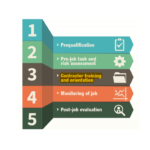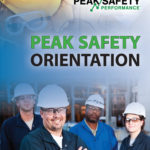National Safety Council
Campbell Institute Research
For the Full NSC Article, Click Here!
Research results show great companies have specific processes in place to manage safety with contractors. Peak Safety Performance helps clients implement each phase of this process with classes such as the Peak Safety Orientation, a regional approach to contractor safety training!
Introduction and Background
The issue of managing contractor EHS performance is an ongoing concern among organizations of all industries, typically because contractors may be performing non-routine work at sites that are not directly supervised by an EHS manager, or any manager at all. Much research has already been done to determine why safety can be negatively impacted through contractors and how much (or little) attention is paid to managing contractor safety. This research report investigates how and why Campbell Institute Members manage contractors on site from prequalification to post-job evaluation, overall exploring cross-industry best practices for contractor management.
For the Full Article, Click Here!
Best Practices
The following subsections outline the best practices in contractor safety management across the contractor life cycle gleaned from the combination of document content analysis, presentations and interviews. Due to their investment in the safety and health of all employees, even those under contract, Campbell Institute organizations have injury rates 6.5 times lower than industry average and lost day rates 6 times lower than industry average (Campbell Institute, 2013). Campbell organizations’ common practices regarding contractor safety management indicate their world-class status in EHS and make the business case for safety.
5 BEST PRACTICES
-
Prequalifcation Process
-
Prejob Task and Risk Assessments
-
Contractor Training & Orientation
-
Monitoring the Job
-
Post Job Evaluation
PREQUALIFICATION
The majority of member organizations involved in the study (10/14) use third-party prequalifying companies or are about to launch a program with one of these companies. One rationale for using external prequalifying agencies is due to the size and number of projects involving contractors at Campbell member organizations, which typically are located all over the world. The widespread use and large scope of contractors in global organizations like Campbell members often necessitates the services of prequalifying companies to handle a large part of the initial vetting process.
For the Full Article, Click Here!
PRE-JOB TASK AND RISK ASSESSMENT
Two-thirds of research participants (9/14) have a method to evaluate the risk rating of the work to be performed (typically per a risk matrix) to place contractors in a predetermined risk category. GeorgiaPacific, for instance, performs an initial risk assessment based on the broad scope of work and a second assessment based on the contractor’s detailed work procedure. Georgia-Pacific utilizes a risk matrix and assigns point values for severity, frequency, and probability to calculate the risk associated with a given project. Projects with higher risk ratings must provide additional written safety programs. A similar process at NASA assesses contractors with a risk matrix looking at incident likelihood, severity, cost, schedule, security, and other factors. NASA’s project technical team requires contractors to describe work plans to mitigate risk.
For the Full Article, Click Here!
CONTRACTOR TRAINING AND ORIENTATION
All organizations require safety orientation and skills training of contractors in order for them to be approved for work. These orientations and trainings are provided on site. All organizations also require special permits or training for specific kinds of work, including (but not limited to) confined space entry, electrical work, hot work, energy control, forklifts, elevated work, etc. Specialized safety training is also provided, including HAZWOPER, hazard identification, PPE, LOTO, fall prevention, etc. At USG, these specialized area trainings are completed through a contracted online program. For Cummins, refresher programs in job-specific areas are held at least annually for long-term suppliers. At BNSF, contractor orientation is conducted via an internal online program. After completion of the online course, contractors receive a badge that must be worn on site. (For additional options for training, continue here.)
For the Full Article, Click Here!
MONITORING OF JOB
Every organization in the study has periodic assessments during the contract term, which varies from daily checklists and/or safety talks to weekly walkthroughs, monthly and yearly assessments. U. S. Steel performs daily inspections of contractor work to assure that it is in compliance with the Pre-Task Safety Plan submitted prior to start of work. U. S. Steel also requires contract employees to submit safety observations; a minimum of two observations per employee per month must be completed and documented. In addition to routine oversight of contractors at Chevron, the monitoring process includes Performance Reviews and Field Verifications, which are major components (collectively 65%) of a contractor’s grade. The frequency of these reviews and verifications are based on the work project’s risk profile and overall contractor grade. To track observations on a daily basis, AECOM uses a mobile application (AECOM LifeGuard) to report non-compliance or unsafe conditions and measure “time to closure” as a leading metric. When a report is logged, the application will alert the contractor and track the time for the report to be closed.
For the Full Article, Click Here!
POST-JOB EVALUATION
A final challenge shared by the participants in this research is the lack of an evaluation of contractors after the work has been completed. Only five participants have a post-job evaluation or specific guidelines for contractor requalification. At Georgia-Pacific, the results of a post-work evaluation are taken into consideration when a contractor bids on future jobs. Cummins has a Safety Performance Assessment of all suppliers once a year or near the end of a contract period. Johnson Controls’ post-job performance assessments take into account safety, customer service, and the quality of finished work. U. S. Steel has a Safety and Operating Inspection completed for every process change, enhancement or facility improvement that is not part of routine maintenance work, which in turn serves as a post-job evaluation. In a similar fashion, Chevron’s periodic Performance Reviews also capture an evaluation of contractor performance after a job has been completed. AECOM’s Industry SafeTM management system records incidents tied to a contractor and saves that information for future use.
For the Full Article, Click Here!
HOW DO YOU START CREATING A BEST PRACTICE
CONTRACTOR SAFETY CULTURE?
PEAK SAFETY ORIENTATION
A Critical Step in Building a Best Practice Contractor Safety Culture!
(For more information, click on the Press Release.)
We deliver standard training that you can trust. Nobody wants to get hurt and people want to stay out of trouble. The Peak Safety Orientation provides a field level perspective on common topics. The class does not waste time talking about the origin of OSHA. The class gives you a “boots on the ground” perspective on what the “Safety Guy” or client is looking for when they walk your job. Do you see what they see?
Fourteen plants in the Upstate recognize the standard Peak Safety Orientation is a class we trust!
The class is offered weekly and it is open to the public. Register here!
FOLLOW OUR PROGRESS ON FACEBOOK. CLICK HERE TO LIKE OUR PAGE.

